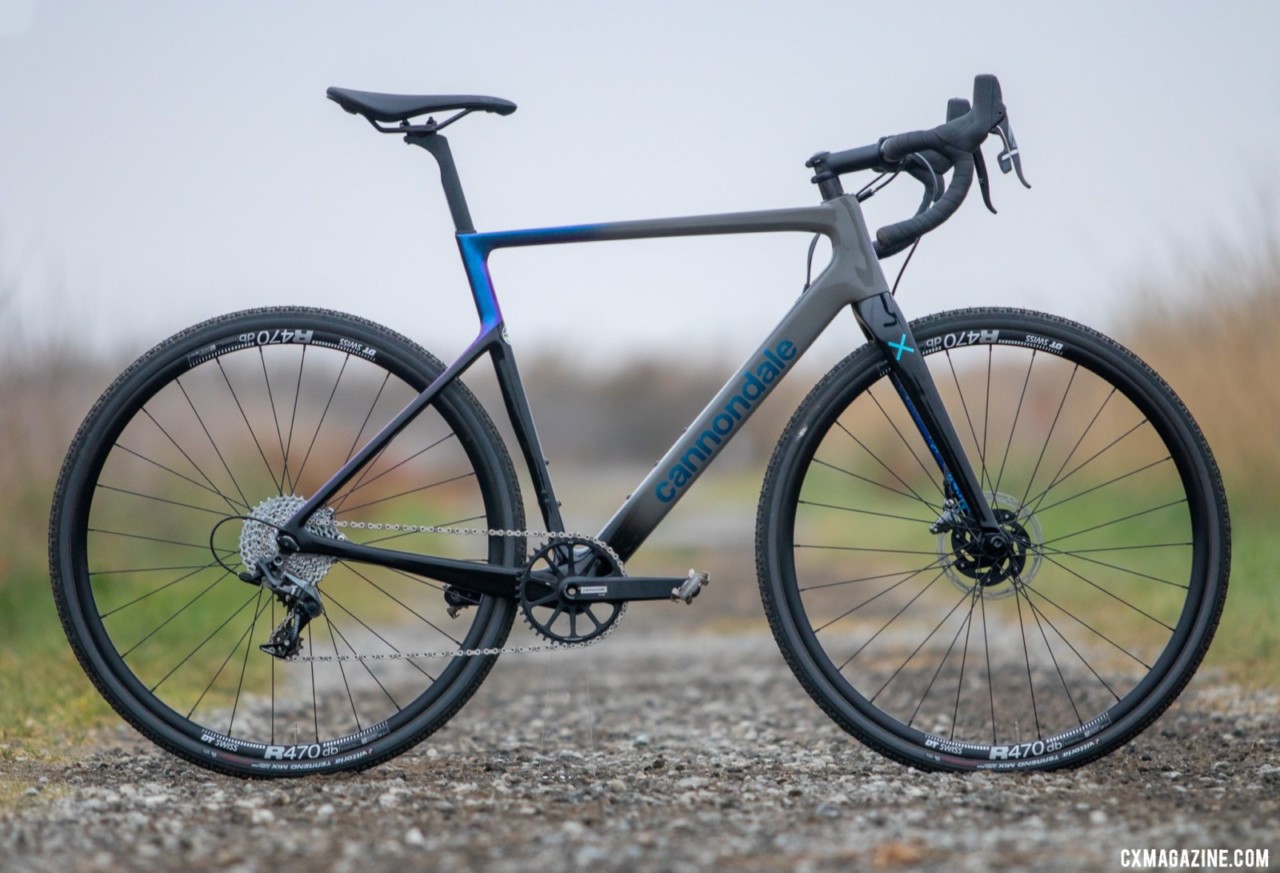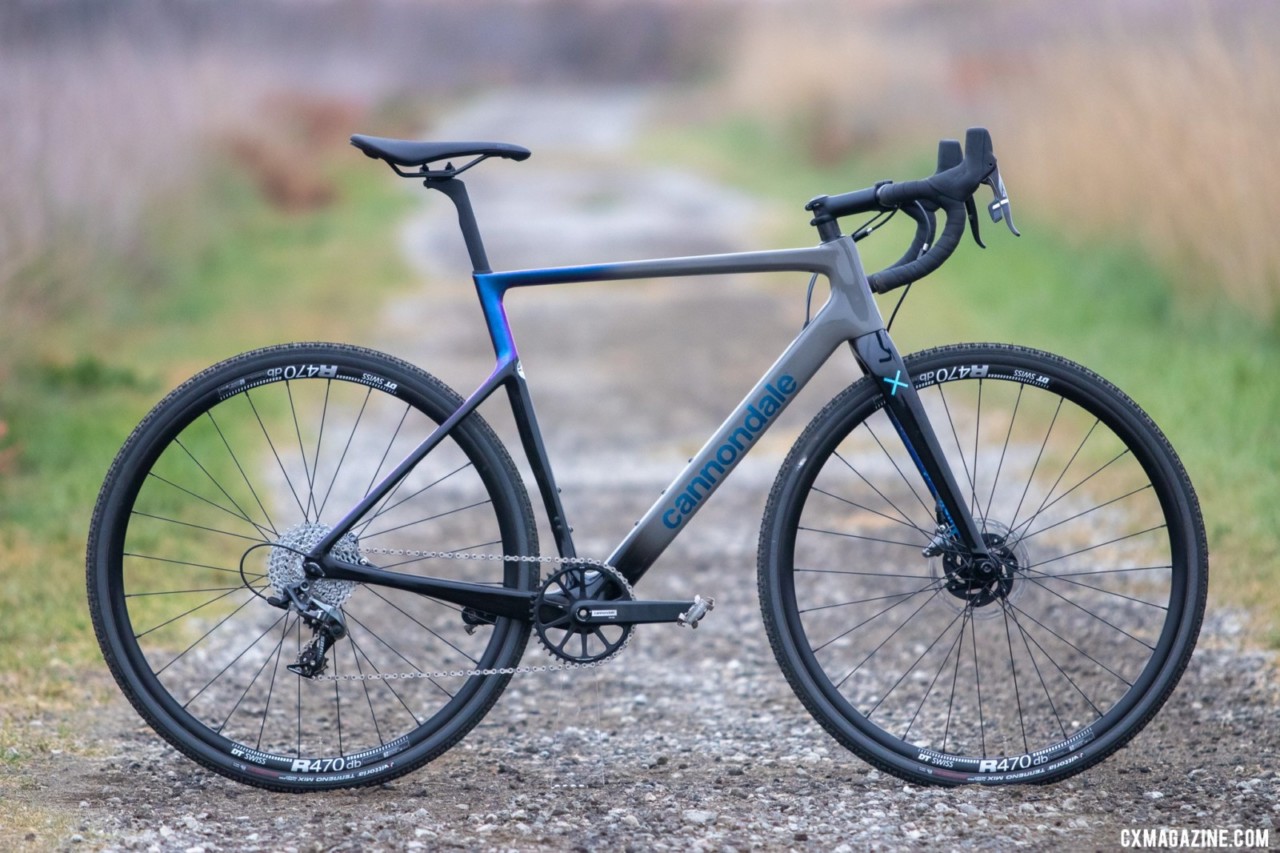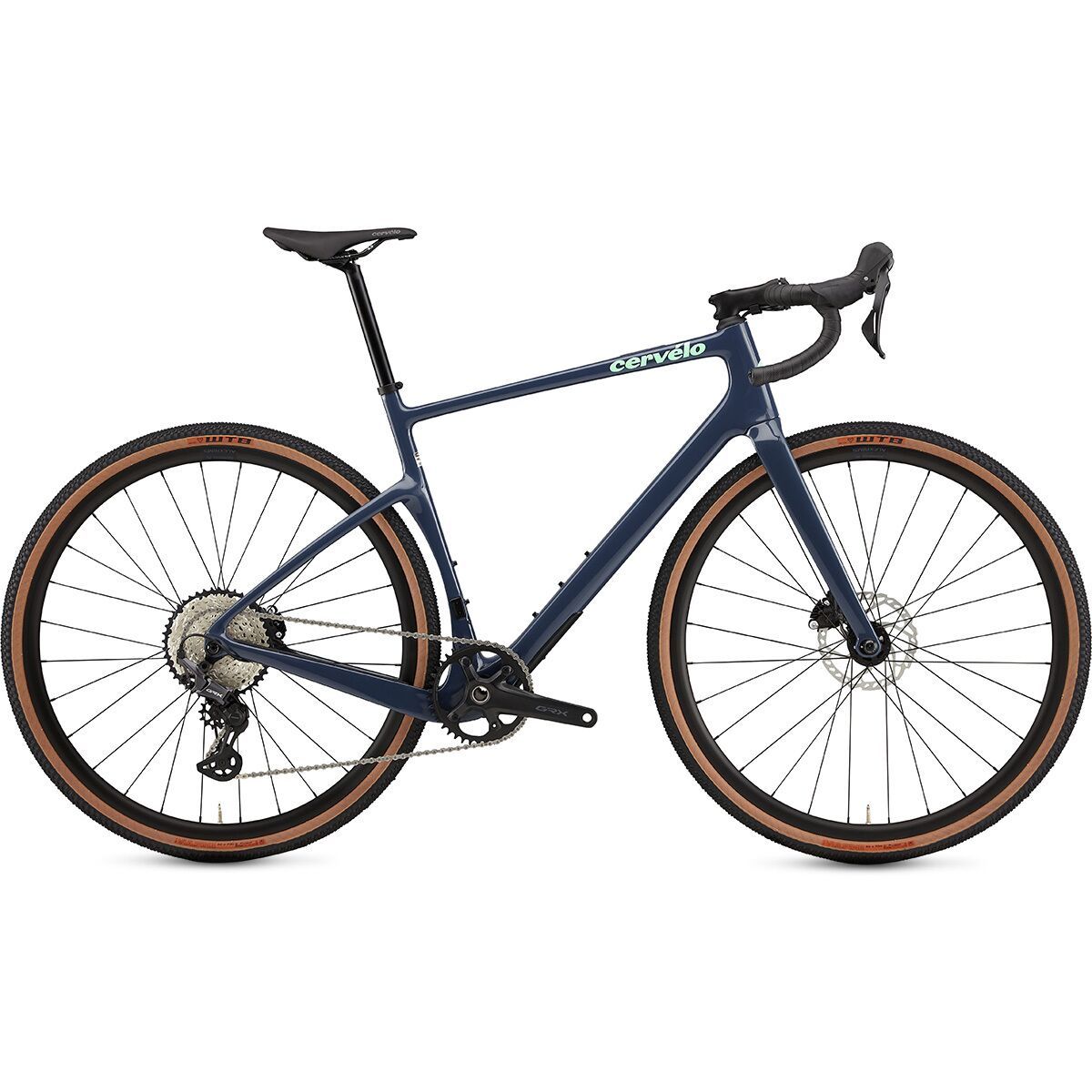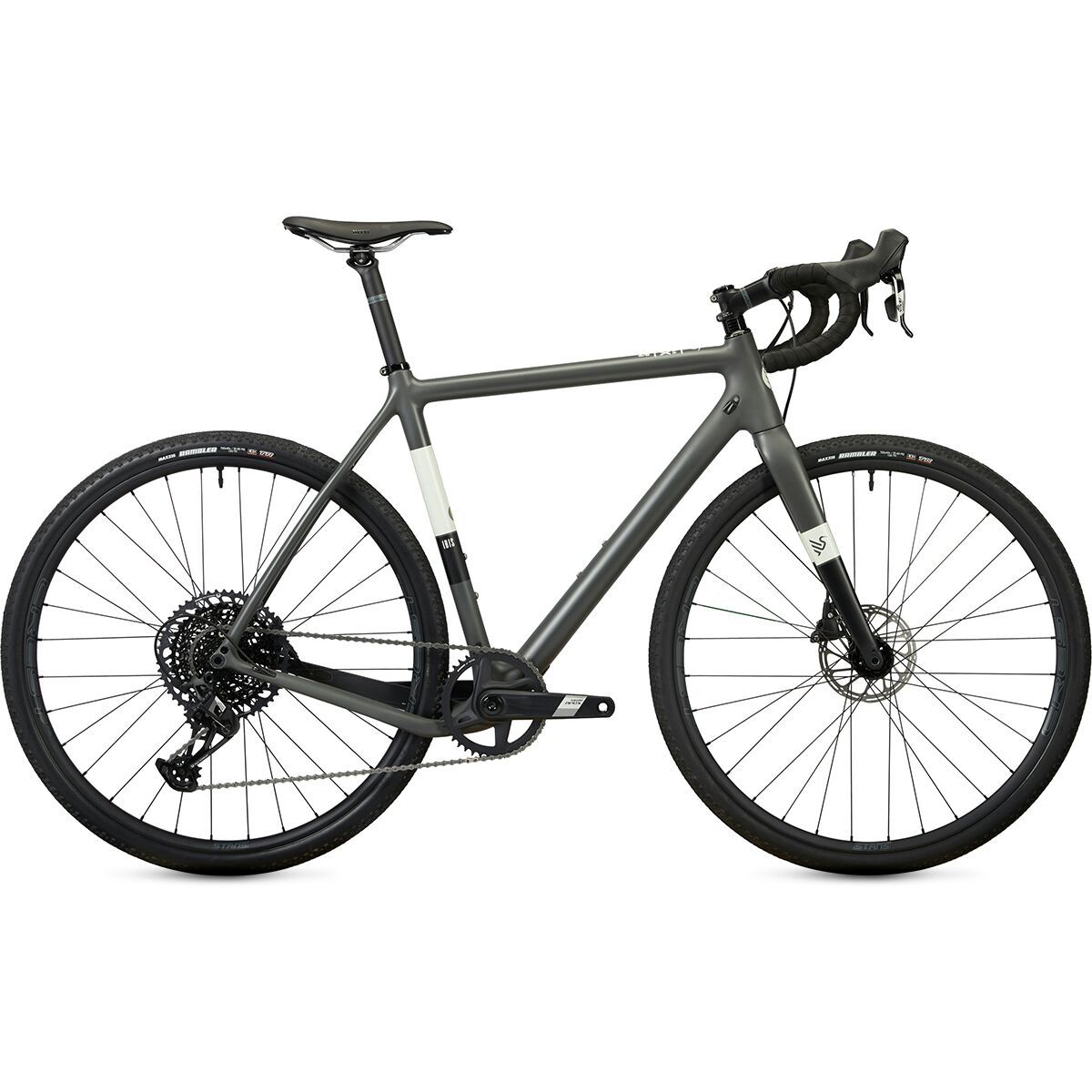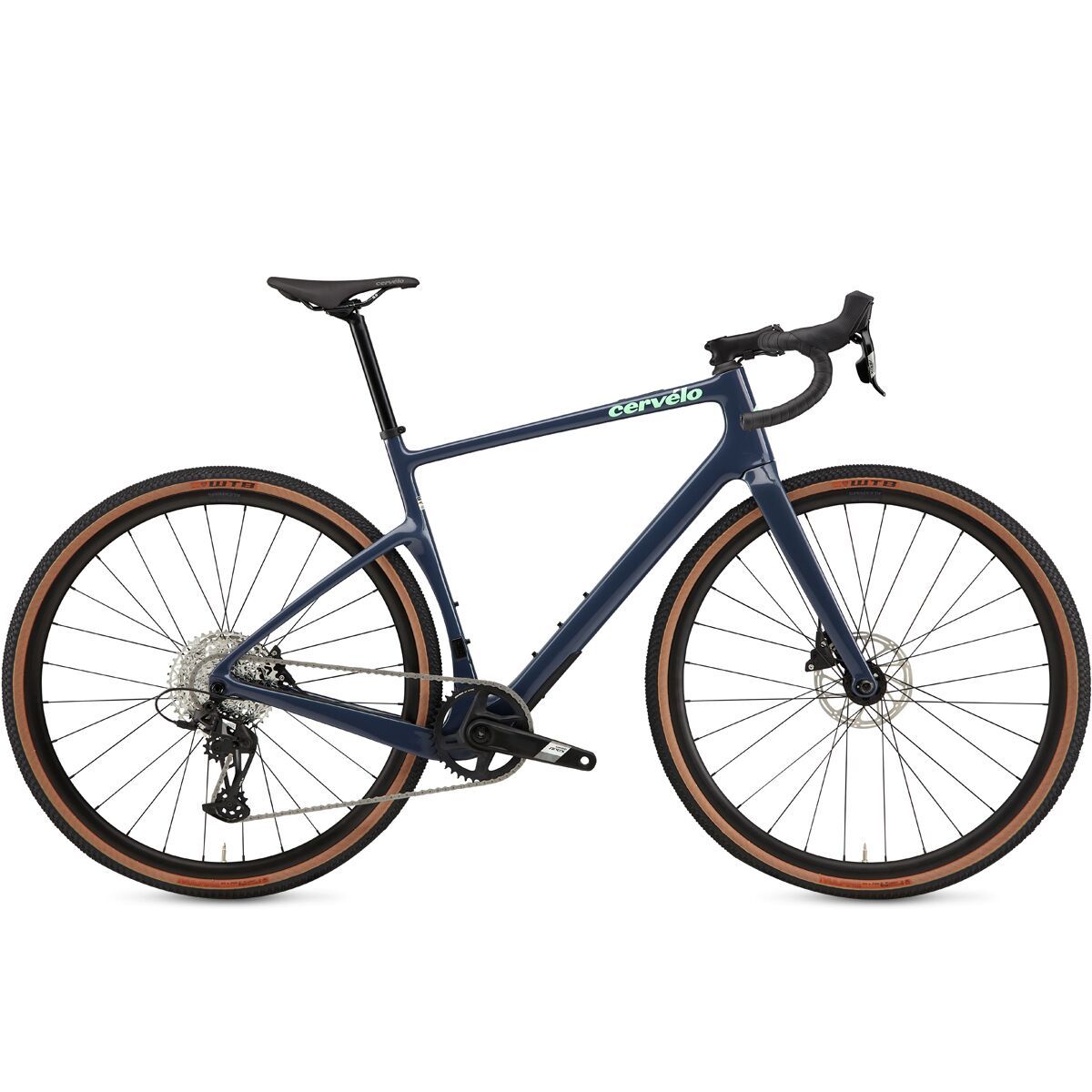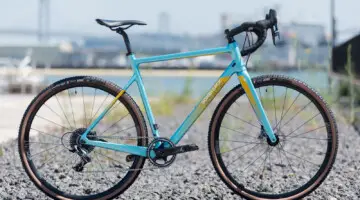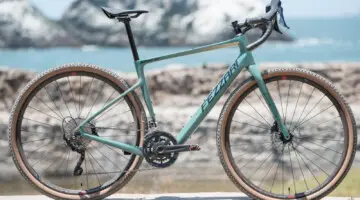Cannondale continues to have a dominant position in cyclocross racing. Reigning USA National Champion Clara Honsinger joined Cannondale P/B Cyclocrossworld.com 2 seasons ago. This year she has had a strong showing in Europe on the new Supersix EVO CX.
Cannondale updated the cyclocross line by eliminating the 3X Nationals winning SuperX ridden by Stephen Hyde and Katie Clouse. In place of the venerable SuperX that introduced the “Out-Front” geometry that Tim Johnson helped implement is the Supersix EVO CX. The same frame is used for a companion model, the Supersix EVO SE equipped with gravel-friendly gearing and tires. The name and aerodynamic design follow from the Supersix EVO top-end all-around road racing bike in Cannondale’s lineup but is not the same frame at all.
Cannondale consulted sponsored athletes for the new design and rode early prototypes to provide feedback and race-focused testing. In particular, the women athletes, Clara Honsinger, Katie Clouse and Katie Keough received early prototypes first. External test partner Mike Berry, team mechanic for Cannondale p/b Cyclocrossworld.com was also included in this process.
Keep What Works
For the Supersix EVO CX, Cannondale kept the out-front geometry of the SuperX. They also kept the AI (Asymmetric Integration) rear end with short 42.2cm chainstays and a 6mm drive-side offset that requires a special crankset and the rear wheel dished 6mm to the left. Additionally, Cannondale uses a bottom bracket of its invention called BB83A. This is press-fit cups into an 83mm wide shell, with the cups the total width is 86mm. Cannondale invented the original BB30 over 20 years ago, so why not continue the trend?
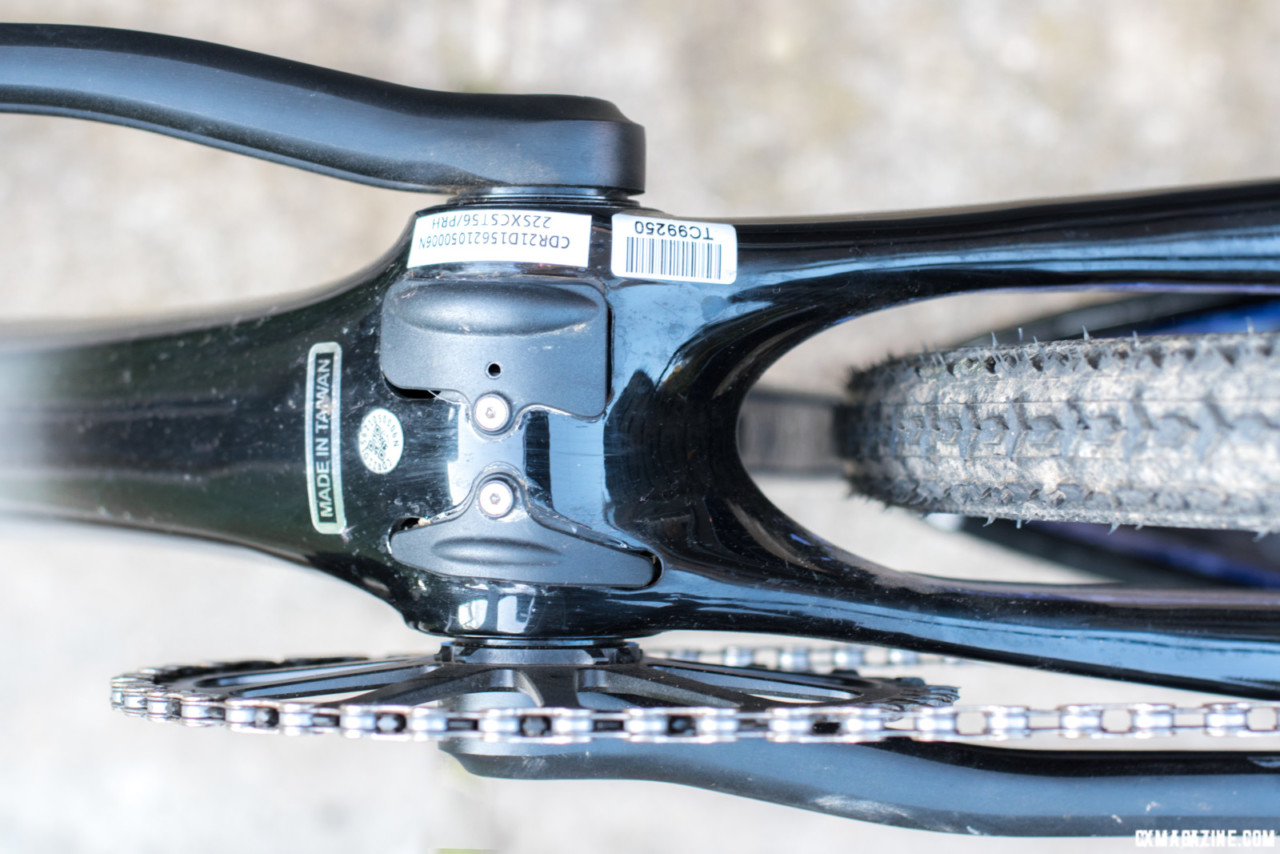
Note the unique chainring offset to maintain a good chain line with Cannondale AI. Also 13 mm of clearance on each side of the 33mm tire. Cannondale SuperSix EVO CX cyclocross/gravel bike review. © Cyclocross Magazine
The Cannondale out-front geometry is a relatively slack 71-degree headtube angle paired with a 55mm long fork offset to maintain a quick 62mm trail figure that makes the bike have a racy feel out on the course, but yields confidence on steep descents and transitions with the front wheel further ahead of the rider. Our 56cm review bike has a long 62.1cm front center. That’s almost 2cm longer than other ‘cross bikes with more typical geometry.
The new Supersix EVO CX or SE frame fits 33mm tires with 13mm of mud clearance on each side! That also means a 50mm tire fits in the rear without a problem. Officially Cannondale says the maximum tire clearance is 45mm.
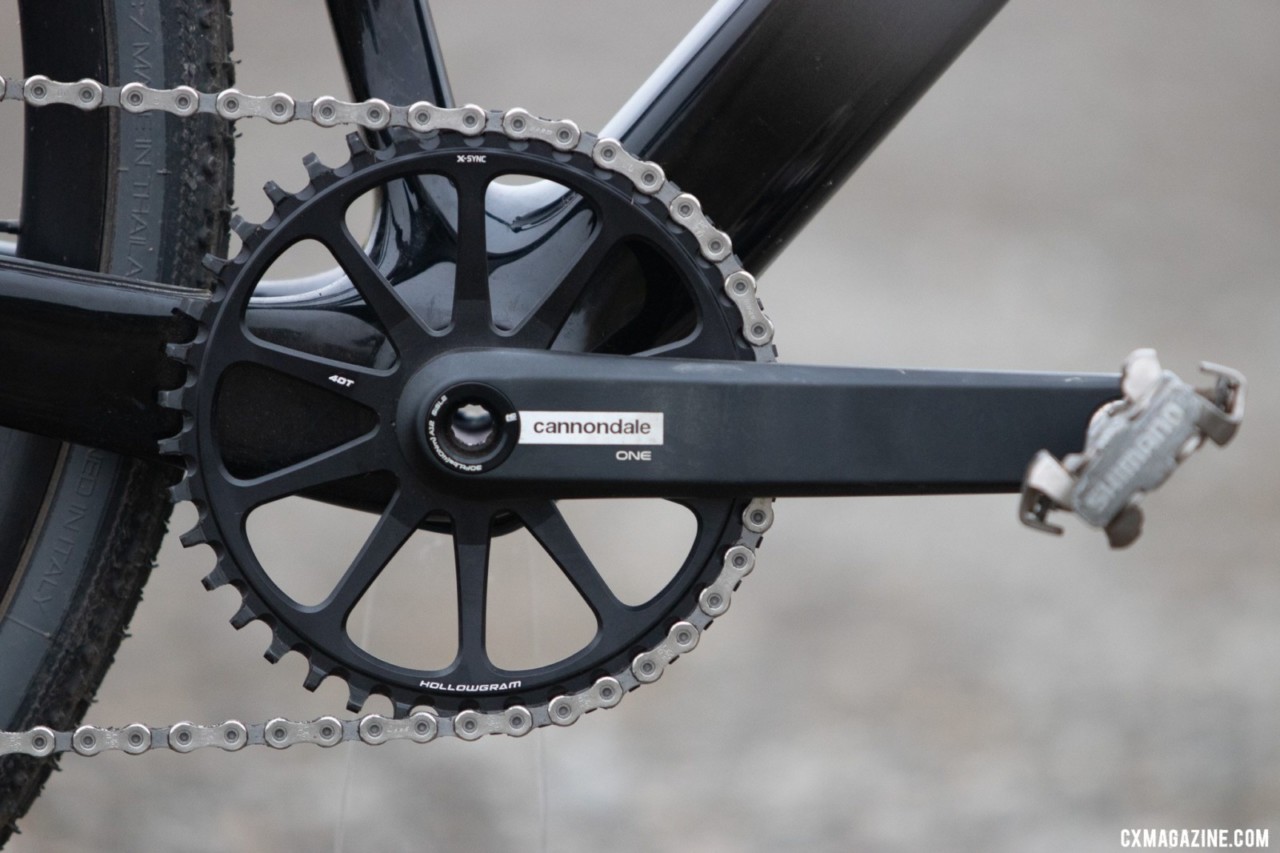
Cannondale One crankset for AI uses a proprietary direct mount chainring. Cannondale SuperSix EVO CX cyclocross/gravel bike review. © Cyclocross Magazine
Our 56cm review sample has a 55.5cm top tube, a 57.5cm stack height, and a 38.5cm reach. The bottom bracket drop is 6.9cm. With the short 42.2cm chainstays, the wheelbase is 103.4, not too much longer than typical given the long front center.
In the past, Cannondale attempted to provide some rear-end compliance via thinned areas of the chain and seatstays. Those areas are not on the new Supersix EVO CX/SE. The seatstays attach lower on the seat tube, a popular style now. I don’t know how this affects compliance, but the ride quality is certainly different than the previous SuperX. Cannondale still uses a wedge-type internal seat post clamp for the D-shaped carbon seat post. The D-shaped post is an aerodynamic design cue straight from the Supersix EVO road bike and does keep the saddle oriented in the event of a spill, two race advantages.
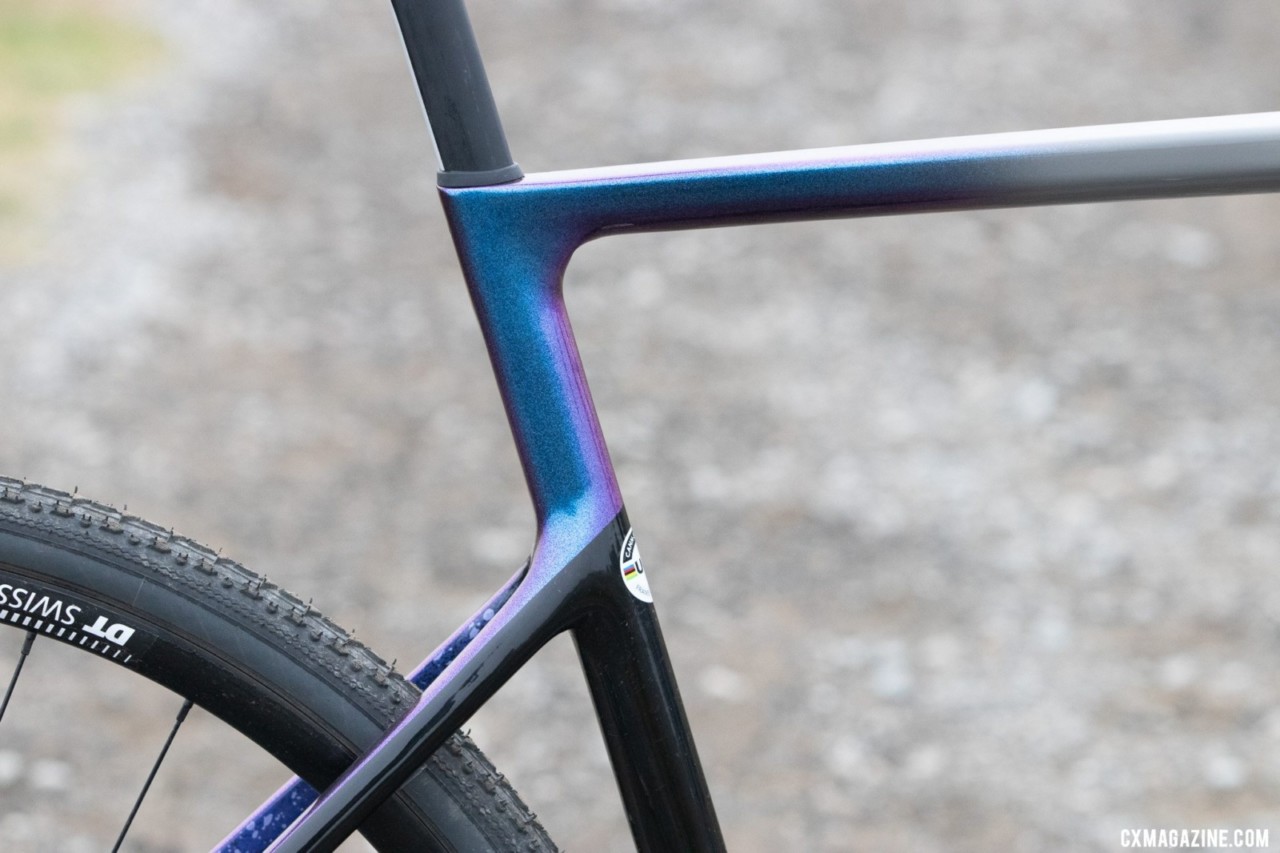
Dropped seatstays and internal seat post clamp add to clean lines. Cannondale SuperSix EVO CX cyclocross/gravel bike review. © Cyclocross Magazine
The Cannondale is attractive with smooth lines expected from a carbon monocoque frame. The dropped seatstays run parallel with the downtube, just like the GT Triple Triangle frames from the old days. The downtube is a rounded isosceles trapezoid with a 30mm wide narrow end forward facing for an aerodynamic shape that is easy to grasp when bringing the bike up to your shoulder. Control lines enter into the top of the downtube to run internally to their destinations with trap doors to access the lines below the bottom bracket. Cables use full housing through the frame. The front brake line enters the left fork blade cleanly from the front of the crown area. This control line arrangement makes maintenance significantly easier than lines run internally through the bars, stem or headtube which has become popular among recent road bike designs.
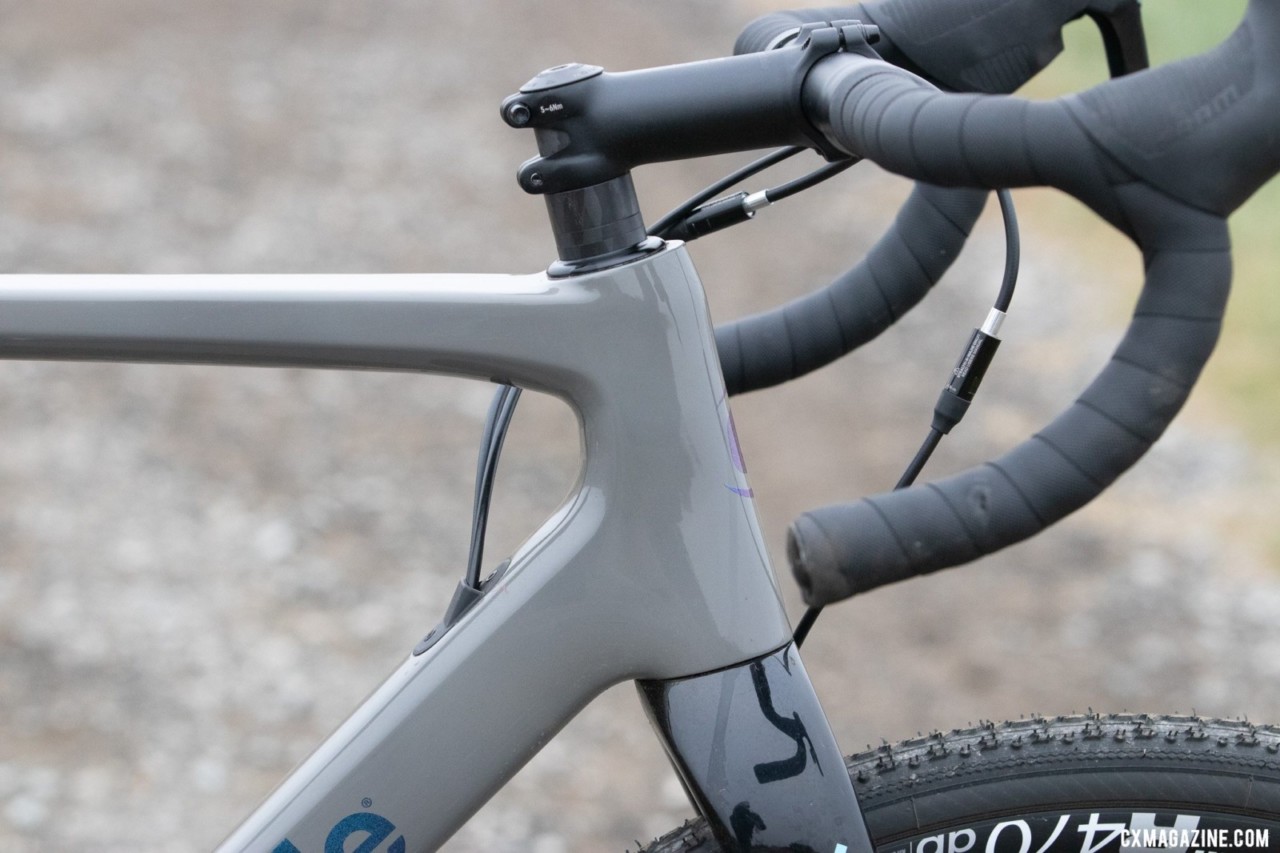
Easy to maintain control line runs on the Cannondale SuperSix EVO CX cyclocross/gravel bike review. © Cyclocross Magazine
Two bottle cages are in the usual places on the down and seat tubes, the former with 3 bolts to offer flexible positioning for an extra-long cage or accessory mount. There are provisions for a front derailleur, cable, wired, or wireless, but no rack or fender mounts. There is however the Speed Release through-axle system we saw most recently on the Wilier Triestina Rave.
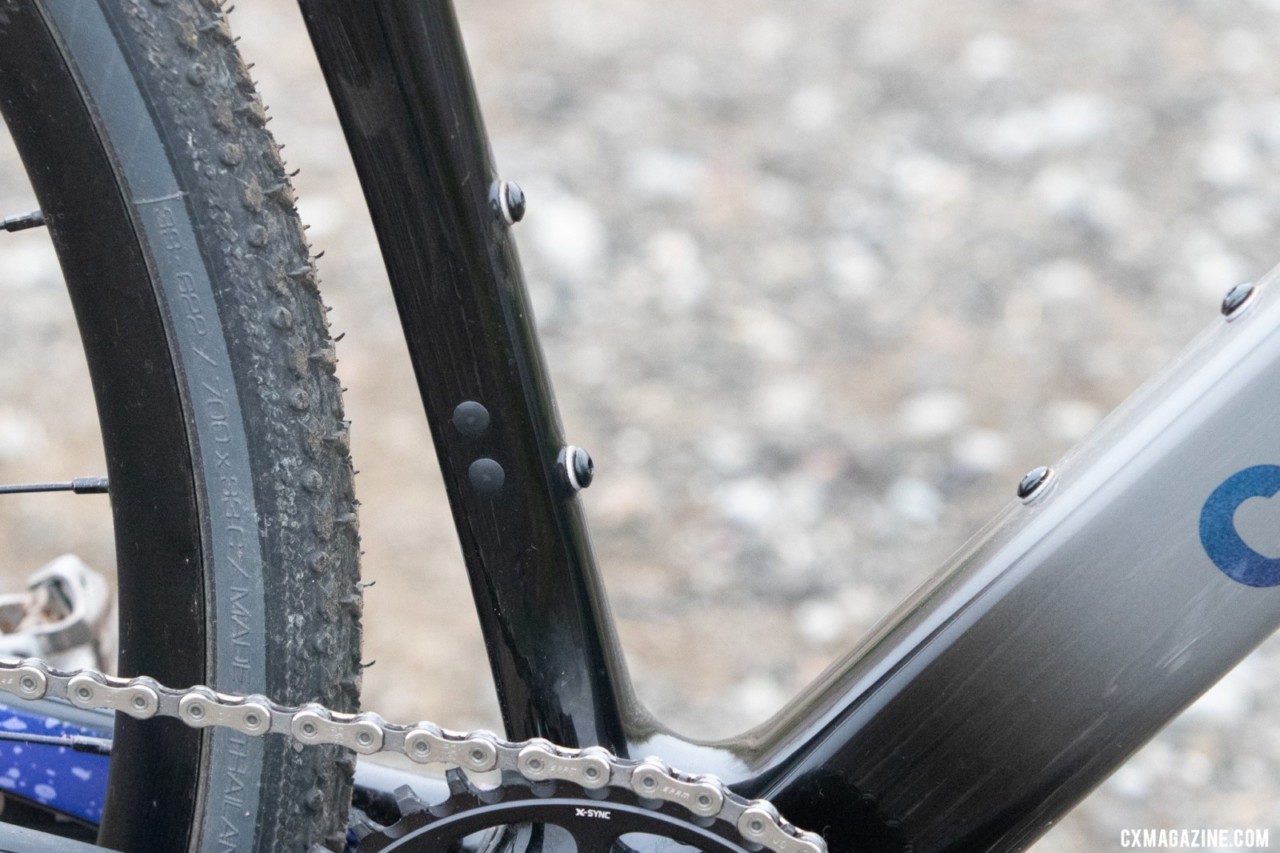
The front derailleur provision is used when the Cannondale SuperSix EVO is dressed in a gravel kit. © Cyclocross Magazine
The fade paint from putty grey to metallic purple adds to the SuperSix EVO CX’s curb appeal.
The Build
The SuperSix EVO CX has a complete kit of Cannondale components including a standard aluminum bar and stem, a Fabric brand saddle. the aforementioned proprietary D-shaped Hollowgram SL carbon seat post with a 2 bolt clamp, and of course the aluminum Cannondale crankset with a single 40t direct-mount chainring. The Drive train is the vulnerable SRAM Force 1 HRD with flat-mount calipers. The rear derailleur is a SRAM Force 1 medium cage that shifts across an 11-36 cassette. The 40 X 36 low gear yields a 1:1.1 ratio or 30 gear inches, a useful racing range for mere mortal cyclocross racers. The bike has SRAM CLX R center lock brake rotors, 160mm front and 140mm rear.
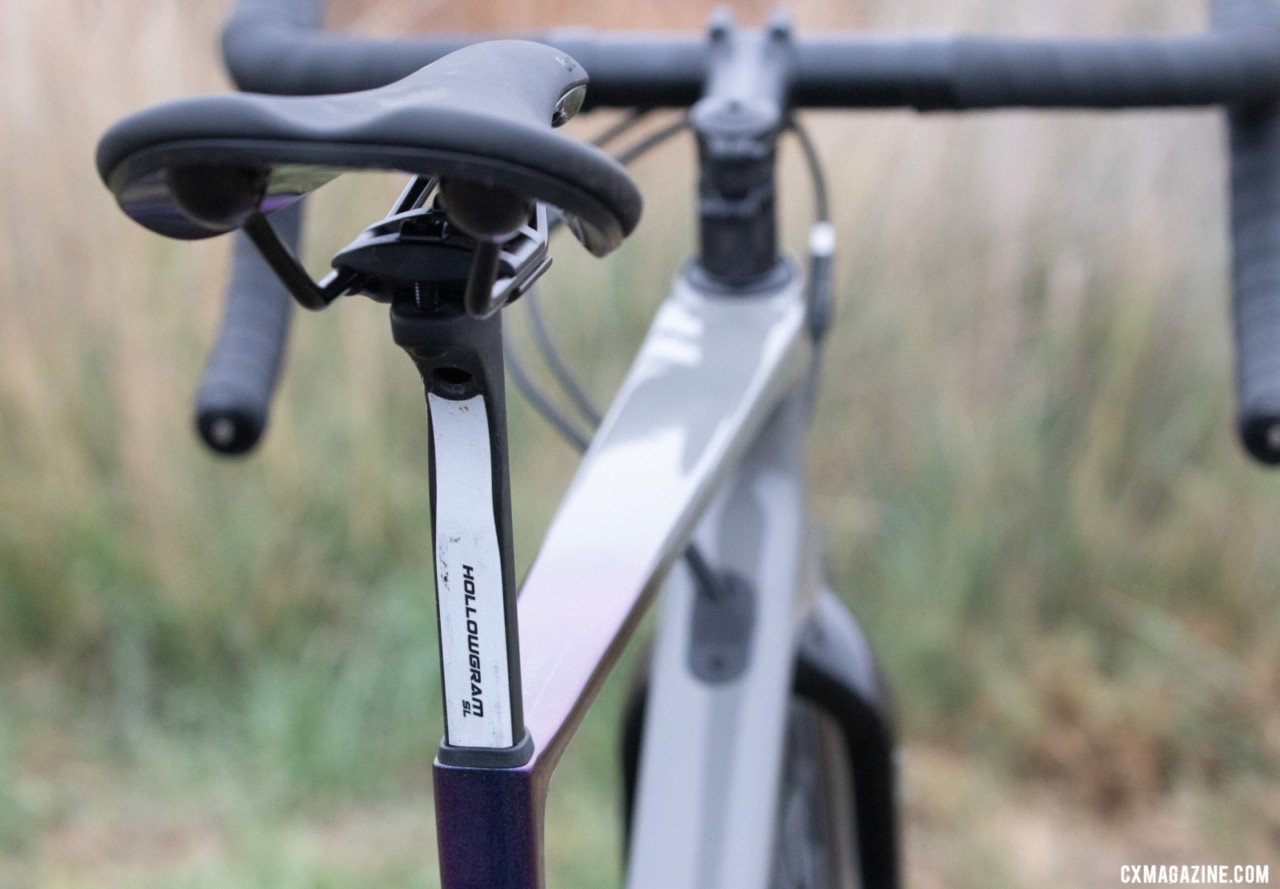
The D-shaped Hollogram carbon seat post. Cannondale SuperSix EVO CX cyclocross/gravel bike review. © Cyclocross Magazine
Cannondale includes DT Swiss R 470 aluminum rims built around Formula hubs with 28 straight 14ga spokes in 3X configuration. The rims have a 20mm internal width tubeless profile and a 23mm depth. This is not a light wheelset by any means with 450-gram rims, but it is a durable build. The tires are Vittoria Terreno Mix TNT, a reliable tubeless ‘cross tire in our experience. The bike came with tubes in the wheels, but it was indeed an easy task to set the Vittoria tires as tubeless on the DT Swiss rims.
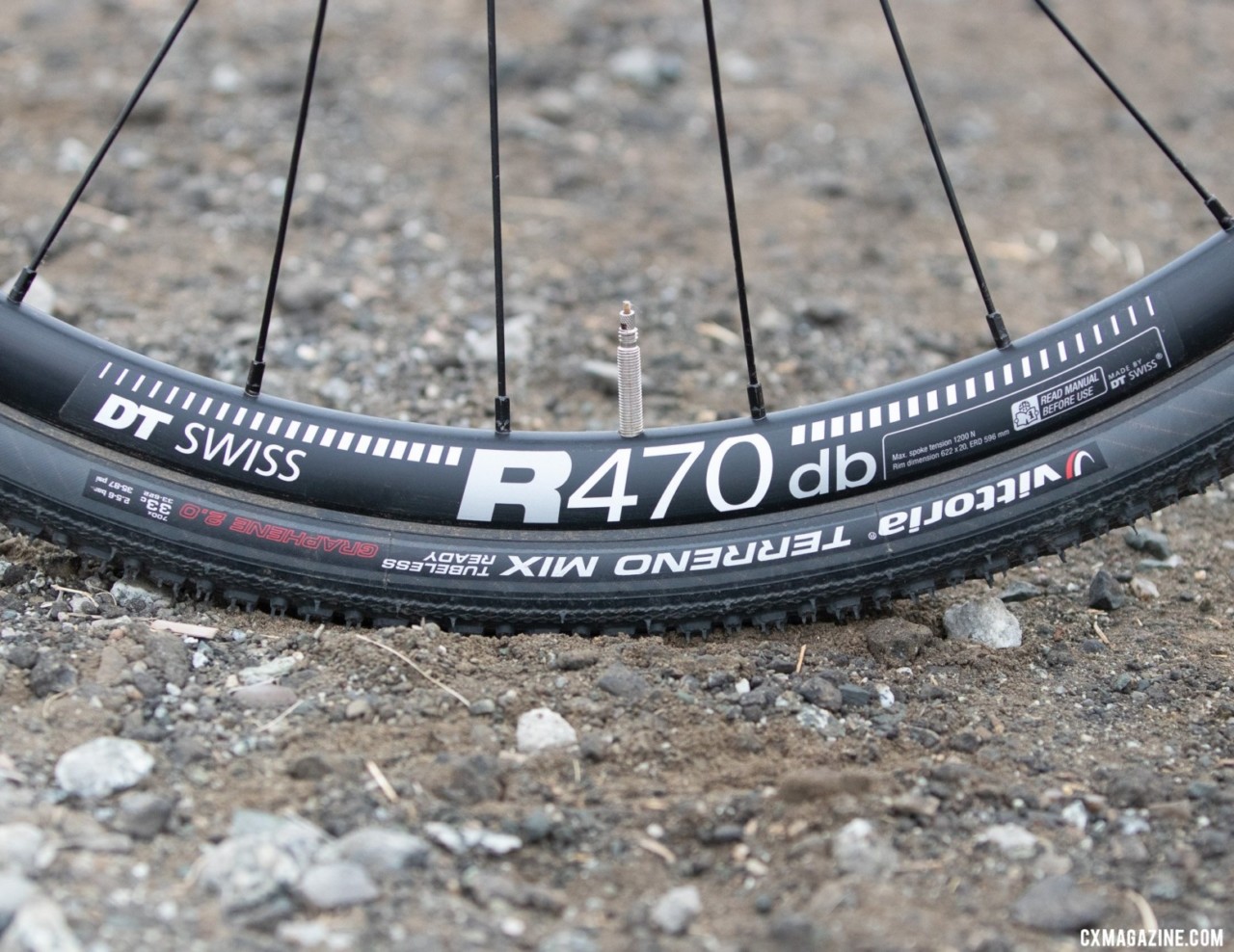
DT Swiss R470 rims with 28 2.0mm spokes X3 is a stout wheel build on the SuperSix EVO CX cyclocross/gravel bike review. © Cyclocross Magazine
18.1 pounds as tested. 10.3 pounds without wheels.
The Ride
I’d come to like the Cannondale out front geometry a lot over the years. The short chainstays add to the handling qualities I like, but I’ve never been one to like a requirement for non-standard components. In practice, owning a Cannondale SuperX has not been a burden since dishing a wheel 6 mm over mostly won’t require longer spokes, and most riders don’t swap wheels quite as often as I do. Cannondale AI direct mount chainrings are available after aftermarket from WolfTooth Components or a spider and chainring combination. SRAM makes a crankset specifically for Cannondale AI, but Shimano users will have to stay with the Cannondale crankset. Other options may exist, especially since Cannondale has stuck with this system for the past 5 years. Other companies use dropped chainstays or sacrifice tire clearance. That said, I can’t help but wonder if Cannondale could have accomplished the same handling with 42.5cm chainstays in a more standard configuration, sacrificing some tire clearance as other companies have done since this is a race-oriented bike.
For the review, I have the advantage of close familiarity with the SuperX with one on hand to draw a comparison for academic discussion. I don’t own the SuperX, and I used the same wheelset between the two bikes to see if there was an immediately noticeable difference. Any ride difference is subtle but the SuperSix EVO CX seems a bit stiffer at the back end over bumpy terrain. Perhaps that is confirmation bias. There are many ways to engineer compliance, especially with a molded carbon composite frame.
Despite my initial comment comparing the smoothness of the old SuperX, the new Supersix EVO CX is not a rough ride, but makes you aware of the surface. The bumpiest track feels bumpy as the control lines rattle inside the downtube. The bike does not have the hard-hit damping that the Trek IsoDecoupler affords, but it is still not too jarring over those hits, and because rider weight is behind the front tire a bit more, the front end rolls over those hits more easily. Seated traction and comfort are aided by seatpost flex that is evident when you push down hard on the saddle statically. The effect is lost when standing on the pedals, but the Supersix EVO CX still feels under control. It accelerates quickly with rider input to the pedals, with a racy responsiveness I enjoy, and similar to the Trek Boone that I just reviewed. The Supersix EVO CX pays back your hard acceleration with some creaks that I surmise are from the bottom bracket with a slight moan from the seat post clamp area since the noise is most noticeable when accelerating while seated. All bikes make noise, but creaking is sometimes an indication of maladjustment, not something I’d expect on a new bike. Inspection of the frame and component interfaces revealed nothing amiss. This creak is conditional, so it does not exist under normal pedaling.
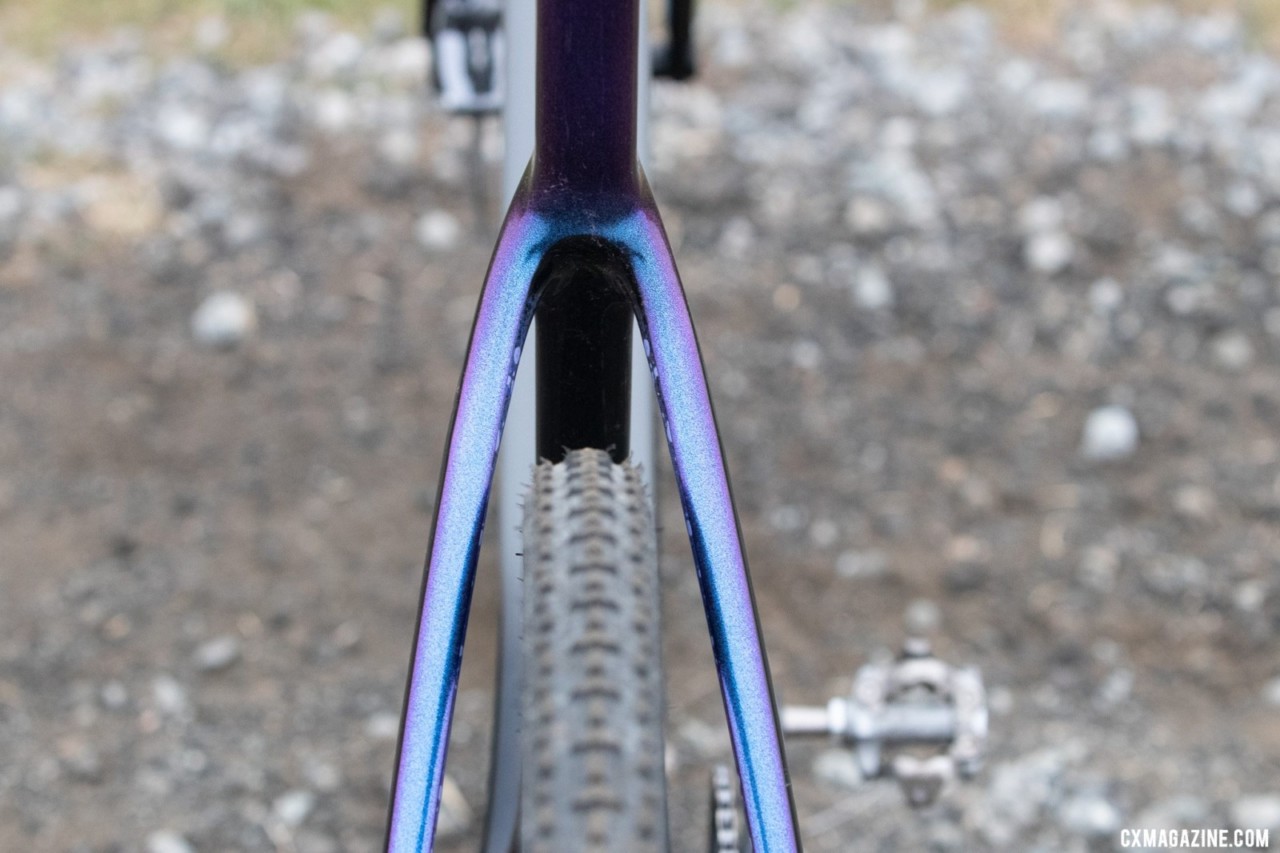
Cannondale SuperSix EVO CX cyclocross/gravel bike review has lots of clearance by the seatstays. © Cyclocross Magazine
With the stock Vittoria Terrano 33mm tires tubeless pumped to 25 psi in the front and 28 psi in the back, the Supersix EVO CX rolls quickly and smoothly over a typical mixed surface CX course. That includes pavement, hardpack, loam, roots, sand, and only minor rocks. The Vittoria has a stiff feeling sidewall, so they never felt folded over in the turns, and did not bottom out easily with the chosen pressure. The tread pattern is similar to the familiar chevron of the European favorite Challenge Grifo, or Dugast Typhoon, but the knobs are taller and more aggressively square-edged. I thought they out-performed a more traditional chevron tread when compared in the same conditions.
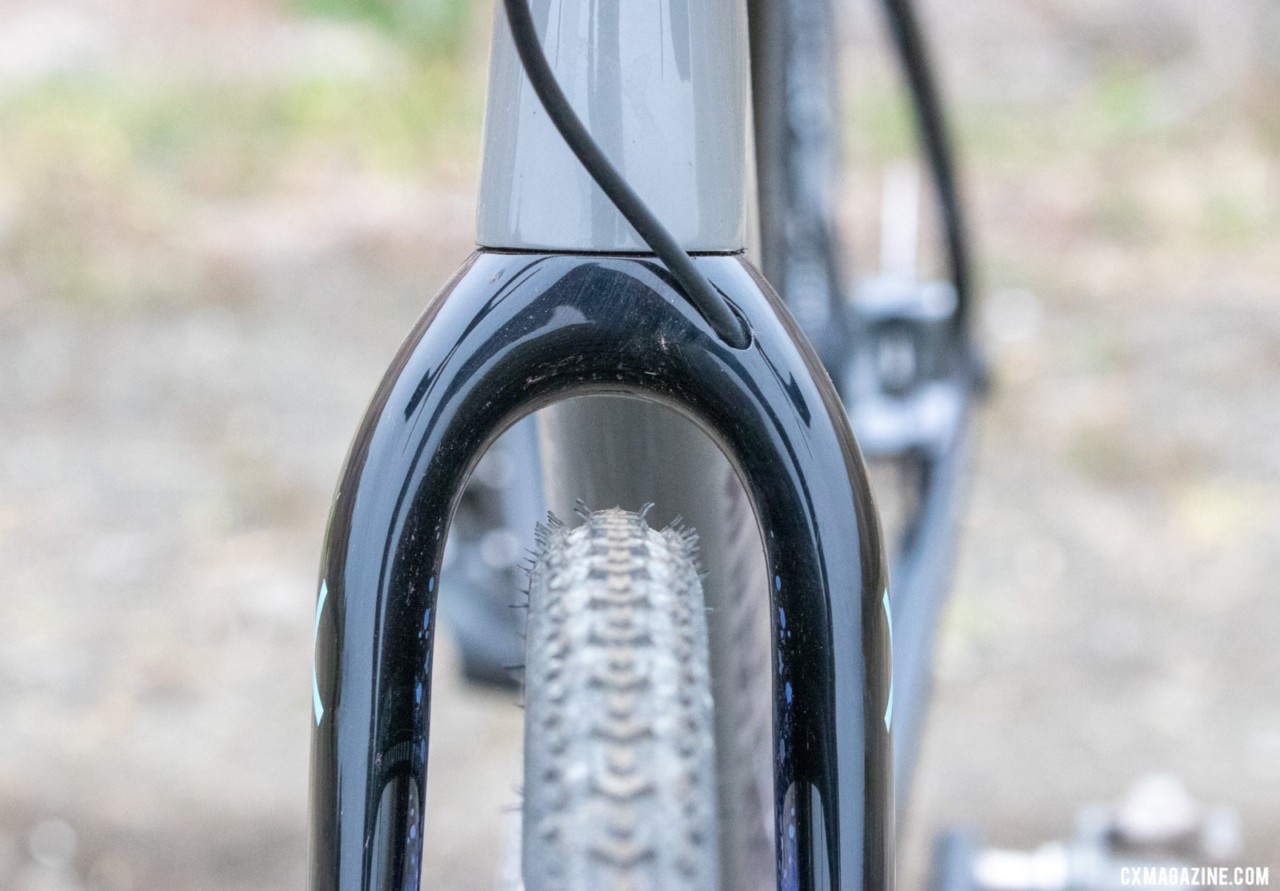
Cannondale With a 33mm tire, there is plenty of clearance at the fork crown for mud or a bigger tire. SuperSix EVO CX cyclocross/gravel bike review. © Cyclocross Magazine
The Out Front geometry puts the front wheel further out in front of the steering axis so I feel more confident when descending steep sections of track. The rider’s weight is further back so the front wheel can roll over unevenness easier and the risk of going over the bars feels mitigated. Yet, wheel flop is not evident, steering is CX race-bike quick, and there certainly is no toe overlap. The trail calculation of 62mm with a 33mm tire is just a hair less than “standard” cyclocross geometry (a 72-degree head angle and 45mm fork offset). The only demerit I can see with the Out Front geometry is a minor reduction of front-wheel traction. On a steep climb or certain off-camber turns, you’ll want to either reach for the drops or sit a bit more toward the front of the saddle. Coming down a steep section into a turn, your weight is already forward, so the long front center poses no problem, the quick steering requires only a lean of the bike.
The SRAM Force 1 medium cage derailleur is appropriate with the 36T low cog since this is a CX build. The Supersix EVO SE in gravel dress comes with a double crankset and front derailleur. For the Supersix EVO CX, easy conversion for off-season adventures is to replace the AI chainring or buy a long cage Force 1 and use a large cassette, a more complicated and expensive option.
The stout wheels included are not race wheels. By my calculations, the build would be more than 1900 grams, a hefty choice for a race bike. The 20mm internal width rims are not a great gravel choice, so these are heavy ‘cross wheels. Given the curb weight of the complete bike, we can imagine how sprightly this bike would be with a lighter wheelset. Given the AI rear end, it is not so easy for me to swap wheels, but I had access to a SuperX with 1600 gram wheels shod with 33mm Maxxis Speed Terrane that I swapped for a ride, similar weight to the Vittoria Terreno. Already good acceleration improved as did nimbleness with the wheel diet.
The Verdict
The Supersix EVO CX keeps all the race-winning pedigree of the SuperX, updates the styling and offers better aerodynamics and more tire clearance. Both attributes make the Supersix EVO CX a better gravel racer, especially with different gearing. However, tire clearance and aerodynamics play a role in cyclocross racing as well, if the mud is thick or the speeds are high (as we saw in the dry conditions of the 2022 Fayetteville World Championships).
Aside from the aforementioned creak, the Supersix EVO CX has no quirks. Control line runs are clean and easy to maintain. The downtube is easy to grasp and the level, flattened top tube leaves a large triangle to reach through to pull up to your shoulder for the long run-up like at the 2022 Cyclocross World Championship course in Fayetteville, Arkansas.
The included wheelset is good to start with, but portly. The bike deserves a lighter more lively wheelset. $4000 is not inexpensive so the additional expense for a wheelset puts the bike budget in the high range. With the right wheelset, this can be a superlight cyclocross racer. Finally, Cannondale’s AI solution for rear tire clearance necessitates several proprietary components or modifications. This is not a big burden for most users who do not swap components frequently, but finding replacements for worn or damaged parts will be less convenient with fewer choices. That aside, the Cannondale Supersix EVO CX is fun to race on the CX course and ride on the mixed terrain rides that I like, with quick handling, responsive acceleration and confidence-inspiring front-end geometry. It was a bike I often chose out of a fairly broad stable of personal and review bikes on hand.
2022 Cannondale Supersix EVO CX Bike Specs:
MSRP: $4000 USD
Frame: Carbon fiber monocoque
Fork: Carbon fiber with carbon steerer: 1 ⅛” -1 ½”
Weight: 18.1 pounds, as tested no pedals; 10.3lbs without wheels or pedals
Shifters: SRAM Force 1 HRD mechanical 11-speed
Crankset: Cannondale One 40T single chainring
Brakes: SRAM Force flat mount hydraulic 160mm front, 140mm rear SRAM CLX R rotors
Cockpit: Cannondale Aluminum, 10cm stem, 42cm bar
Seatpost: Cannondale Hollowgram carbon, D-shaped, 2-bolt saddle clamp
Saddle: Fabric, steel rails
Wheels: DT Swiss R 470, 20mm inner width aluminum, 28 2.0mm spokes, laced X3, Formula CL 712 hubs
Tires: Vittoria Terrano Mix TNT 700X33 tubeless
Warranty: Lifetime, frame and fork (original owner)
Country of origin: Taiwan
More info: cannondale.com













